 Othman Awang, in the Malaysian village of Kepala Bukit, rescues his cat and pet goose from floodwaters. Via the Daily Irrelevant.
Othman Awang, in the Malaysian village of Kepala Bukit, rescues his cat and pet goose from floodwaters. Via the Daily Irrelevant.
12.31.2005
Pet rescue
 Othman Awang, in the Malaysian village of Kepala Bukit, rescues his cat and pet goose from floodwaters. Via the Daily Irrelevant.
Othman Awang, in the Malaysian village of Kepala Bukit, rescues his cat and pet goose from floodwaters. Via the Daily Irrelevant.
Eric Fischl: George Talks to God
 Artist Eric Fischl tries his hand at turf usually reserved for Get Your War On. Click image for larger version of George Talks to God.
Artist Eric Fischl tries his hand at turf usually reserved for Get Your War On. Click image for larger version of George Talks to God.
Cross-cultural poetics
Via The Nonist, a link to the University of Pennsylvania's Cross-Cultural Poetics radio show. Hear tons of audiofiles of poets from around the world: San Francisco's Michael Palmer, on the dilemma of poetry in the Age of Bush; Egyptian poets Mohamed Metwalli and Maged Zaher with Chinese poet Zhang Er on poetry and dissent; Malaysian poet Eddin Khoo on, among other topics, the minority Hindu population in Muslim Malaysia; and big names like Alice Notley, C.D Wright, Wang Ping, Russell Banks, and Robert Creeley.
Happy Leap Second
2005 was a long year, but tonight it gets longer: at the stroke of midnight, the Paris Observatory will add an extra second to clocks worldwide in what's known as a leap second. Every seven years, such a thing happens, to synch up clocks with the solar time measured by astronomers.
12.29.2005
Bangkok street art
12.28.2005
Best links of 2005
 Thanks to Jason Kottke for including my autograph project, "Hello My Name is..." as one of the best links of 2005. Above, my name as signed by Studs Terkel.
Thanks to Jason Kottke for including my autograph project, "Hello My Name is..." as one of the best links of 2005. Above, my name as signed by Studs Terkel.
12.23.2005
Happy New Year
One of the constantly shocking things to me about blogging is how poor my memory is and how the American news cycle seems to compact history. Looking back on the last 12 months of blogging, I'm reminded that we started out this year with the aftermath of a tsunami, which left CNN's bloated bodies floating face-down through my dreams for weeks. It was the year of Terri Schiavo (wasn't that 2004?), of Ratzinger and Harriet Miers and Pat Robertson (who famously said activist judges are a worse threat than al-Qaeda, and called for the assassination of Hugo Chavez). The Downing Street Memos were leaked, Cindy Sheehan had her galvanizing moment in the ditch, and support for Bush, the GOP, and the war in Iraq all started unraveling (remember this guy's "
bullshit detector"?). It was also a year of deaths and births, with heroes dying—Susan Sontag, Rosa Parks, Saul Bellow, Sens. Gaylord Nelson and Bill Proxmire, and Congresswoman Shirley Chisholm—and new paths emerging (more on this later).
As I head off for a week away from the blog, I've been looking back at the year. I feel like Eyeteeth has turned a corner: I'm getting a few more readers, I'm focusing more on art and innovations than on venting my spleen
about politics, and I'm enjoying blogging more. So in 2006, come back for more, including, hopefully, an all-new design.
Here's a few of my favorites from 2005 to tide you over til I return:
Divinity for the Reality-Based Community: how can art connect us to the divine without distracting us with religion?
A good way to die: Scott Nearing's life was about integrity—inner values integrated with external expressions—and having lived it well, he decided when and how to die.
Bush in a skirt!
September was a doozy: Hurricane Katrina really pissed me off, and a life-changing trip to Berlin dominated the blog.
It's all about me: after many years, I finally got my autograph project online, posting examples of celebrities who used their pens to sign my name.
A year-end plea: Love thy bro!
bullshit detector"?). It was also a year of deaths and births, with heroes dying—Susan Sontag, Rosa Parks, Saul Bellow, Sens. Gaylord Nelson and Bill Proxmire, and Congresswoman Shirley Chisholm—and new paths emerging (more on this later).
As I head off for a week away from the blog, I've been looking back at the year. I feel like Eyeteeth has turned a corner: I'm getting a few more readers, I'm focusing more on art and innovations than on venting my spleen
about politics, and I'm enjoying blogging more. So in 2006, come back for more, including, hopefully, an all-new design.
Here's a few of my favorites from 2005 to tide you over til I return:
Divinity for the Reality-Based Community: how can art connect us to the divine without distracting us with religion?
A good way to die: Scott Nearing's life was about integrity—inner values integrated with external expressions—and having lived it well, he decided when and how to die.
Bush in a skirt!
September was a doozy: Hurricane Katrina really pissed me off, and a life-changing trip to Berlin dominated the blog.
It's all about me: after many years, I finally got my autograph project online, posting examples of celebrities who used their pens to sign my name.
A year-end plea: Love thy bro!
12.22.2005
Snakes on a Plane!!
 Plot summary, title, marketing angle, all rolled into one: that’s the brilliance of the title of Samuel L. Jackson’s upcoming film.
Plot summary, title, marketing angle, all rolled into one: that’s the brilliance of the title of Samuel L. Jackson’s upcoming film.
For what it's worth...
Of 60,384+ responses on MSNBC's poll question "Do you believe President Bush's actions justify impeachment?," 87% said yes.
12.21.2005
Who they're spying on...
A letter writer in today's Strib asks: "Who is the National Security Agency spying on? Names chosen from a phone book? Political opponents? From what I gather from limited news reports, the numbers and e-accounts that were monitored were discovered in places like the hard drives and phone books of captured Al-Qaida operatives. It seems to me the only people in 'danger' are those who cooperate with terrorists."
Think again. FBI documents released by the ACLU yesterday outline numerous surveillance and intelligence-gathering operations targeting lawfully assembling groups like the Catholic Worker Movement and Greenpeace. The Catholic Workers, founded by Dorothy Day on the radical "belief in the God-given dignity of every human person," were targeted because of their "semi-communistic ideology." The documents reveal that the FBI's counterterrorism agents monitored the activities of groups dealing with the environment, poverty reduction, peace activism, and animal cruelty. The ACLU suspects that as many as 150 protest and social justice groups may have been improperly monitored by the feds.
Think again. FBI documents released by the ACLU yesterday outline numerous surveillance and intelligence-gathering operations targeting lawfully assembling groups like the Catholic Worker Movement and Greenpeace. The Catholic Workers, founded by Dorothy Day on the radical "belief in the God-given dignity of every human person," were targeted because of their "semi-communistic ideology." The documents reveal that the FBI's counterterrorism agents monitored the activities of groups dealing with the environment, poverty reduction, peace activism, and animal cruelty. The ACLU suspects that as many as 150 protest and social justice groups may have been improperly monitored by the feds.
12.20.2005
Badass bedside table
 The Safe Bedside Table converts from quaint night stand to bludgeon and shield in seconds flat.
The Safe Bedside Table converts from quaint night stand to bludgeon and shield in seconds flat.(Via AWV.)
The I Word
 As legal scholars weigh in on whether Bush's admission that he authorized wiretapping of American citizens without a court order is a criminal act, it's not just kooks like Ramsey Clark who are calling for impeachment. U.S. Rep. John Lewis called for it on Monday, and Sen. Russ Feingold chided Bush: "The President does not get to pick and choose which laws he wants to follow. He is a president, not a king." Even former White House Counsel John Dean, part of Nixon's cabinet, says the unauthorized surveillance of citizens is an "impeachable offense" that's specifically forbidden in the Foreign Intelligence Surveillance Act, passed in 1978 in response to Nixon's electronic eavesdropping.
As legal scholars weigh in on whether Bush's admission that he authorized wiretapping of American citizens without a court order is a criminal act, it's not just kooks like Ramsey Clark who are calling for impeachment. U.S. Rep. John Lewis called for it on Monday, and Sen. Russ Feingold chided Bush: "The President does not get to pick and choose which laws he wants to follow. He is a president, not a king." Even former White House Counsel John Dean, part of Nixon's cabinet, says the unauthorized surveillance of citizens is an "impeachable offense" that's specifically forbidden in the Foreign Intelligence Surveillance Act, passed in 1978 in response to Nixon's electronic eavesdropping. But maybe a parallel with Clinton, as well as Nixon, is in order. Both guys fibbed about the details. In a 2004 speech (sadly, not under oath), Bush lied through his teeth, failing to mention that he OK'd citizen surveillance two years earlier:
[A] wiretap requires a court order. Nothing has changed, by the way. When we're talking about chasing down terrorists, we're talking about getting a court order before we do so. It's important for our fellow citizens to understand, when you think Patriot Act, constitutional guarantees are in place when it comes to doing what is necessary to protect our homeland, because we value the Constitution.More Bush wiretap lies here.
Dispatch from the liberal media: The New York Times, it seems, sat on the illegal wiretapping story, waiting to publish it only after the presidential election.
Update: US Rep. John Conyers is serious about holding Bush and Cheney accountable for their abuses of power. He's introducing three resolutions that could impose penalties ranging from censure to impeachment—and not for the domestic wiretapping charge: he wants an investigation into Bush's and Cheney's manipulation of prewar intelligence.
Stalin's monkeyman militia
 The Scotsman reports that Soviet dictator Josef Stalin ordered the creation of a super-army consisting of man/ape cross-breeds. Newly revealed documents in Moscow archives show that Stalin conscripted scientist Ilya Ivanov in the 1920s to, in Stalin's words, create an "invincible human being, insensitive to pain, resistant and indifferent about the quality of food they eat." Luckily, the usually successful horse breader Ivanov failed in his endeavor:
The Scotsman reports that Soviet dictator Josef Stalin ordered the creation of a super-army consisting of man/ape cross-breeds. Newly revealed documents in Moscow archives show that Stalin conscripted scientist Ilya Ivanov in the 1920s to, in Stalin's words, create an "invincible human being, insensitive to pain, resistant and indifferent about the quality of food they eat." Luckily, the usually successful horse breader Ivanov failed in his endeavor:[I]n 1926 he was dispatched to West Africa with $200,000 to conduct his first experiment in impregnating chimpanzees. Meanwhile, a centre for the experiments was set up in Georgia - Stalin's birthplace - for the apes to be raised.[image]
Mr Ivanov's experiments, unsurprisingly from what we now know, were a total failure. He returned to the Soviet Union, only to see experiments in Georgia to use monkey sperm in human volunteers similarly fail.
12.19.2005
microfab
 While prefab architecture is all the rage, it's disappointing how a technology developed to be affordable is increasingly too expensive to meet needs beyond the collecting and vacation-home needs of the well-to-do. So I like the thinking behind projects like the Urban Nomad Shelter and the Danish collective n55's Micro Dwellings. The latter are modular spaces that can be expanded to match the needs of growing (or shrinking) families, and can be placed on rooftops or submerged entirely or partially underwater. With each pod taking the form of truncated octahedrons, the units can be reconfigured, created from affordable materials (in this case steel), and can take advantage of durable geometric forms. Options include wheels for mobile uses and add-on storage units and rooftop greenhouses.
While prefab architecture is all the rage, it's disappointing how a technology developed to be affordable is increasingly too expensive to meet needs beyond the collecting and vacation-home needs of the well-to-do. So I like the thinking behind projects like the Urban Nomad Shelter and the Danish collective n55's Micro Dwellings. The latter are modular spaces that can be expanded to match the needs of growing (or shrinking) families, and can be placed on rooftops or submerged entirely or partially underwater. With each pod taking the form of truncated octahedrons, the units can be reconfigured, created from affordable materials (in this case steel), and can take advantage of durable geometric forms. Options include wheels for mobile uses and add-on storage units and rooftop greenhouses.
Hustlequeen
 Ever since he was 17, Rich Barlow wanted to mix Queen's "Another One Bites the Dust" with the disco hit, "The Hustle." When he finally did, he geeked it out magnificently, sampling a Laurie Anderson spoken-word piece about Nicola Tesla, "Electricity" by Captain Beefheart, and "Shut Up!" by The Monks. A painter in Minneapolis who's also co-artistic director of Flaneur Productions and guitarist for The Pins, Rich explains:
Ever since he was 17, Rich Barlow wanted to mix Queen's "Another One Bites the Dust" with the disco hit, "The Hustle." When he finally did, he geeked it out magnificently, sampling a Laurie Anderson spoken-word piece about Nicola Tesla, "Electricity" by Captain Beefheart, and "Shut Up!" by The Monks. A painter in Minneapolis who's also co-artistic director of Flaneur Productions and guitarist for The Pins, Rich explains:[I]n college I used to joke with my friend Scott about recording it, and he said I should sample Laurie Anderson saying "this is the dance of electricity," which is where that idea came from. I think he was imagining more like just that phrase, in a "n-n-n-n-nineteen" kind of way, but when I listened to the whole thing I loved the crazy science lecture bit...Listen to "Hustlequeen" [mp3].
12.16.2005
Tookie stencil
 Visual Resistance offers a free downloadable stencil featuring the recently executed Tookie Williams, along with some thought-provoking analysis.
Visual Resistance offers a free downloadable stencil featuring the recently executed Tookie Williams, along with some thought-provoking analysis. Drop by.
RIP Bill Proxmire
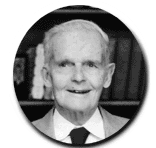 Growing up in Wisconsin, Sen. William Proxmire (D-WI) was always something of a family hero, but most of the world knows him as the creator of The Golden Fleece Awards, an annual highlight of "outrageous waste" of taxpayer dollars by the US government. Let's remember his death yesterday at age 90 with a link to the Golden Fleece Top 10.
Growing up in Wisconsin, Sen. William Proxmire (D-WI) was always something of a family hero, but most of the world knows him as the creator of The Golden Fleece Awards, an annual highlight of "outrageous waste" of taxpayer dollars by the US government. Let's remember his death yesterday at age 90 with a link to the Golden Fleece Top 10.And: Following in the footsteps of Proxmire and Minnesota's recently departed Eugene MacCarthy, Wisconsin Senator Russ Feingold is fightin' the good fight over the Patriot Act. Once the lone voice of dissent on this invasive provision, he's now joined by two dozen other senators, which may make a filibuster of the act a possibility. Send him a note of thanks here.
Herbicides for fire prevention?
The US Bureau of Land Management wants to douse 932,000 acres of land in 17 western states with 18 different kinds of herbicides each year to reduce fire risk. TheOrganic Consumers Association:
Sign OCA's petition to the BLM here.
The pesticides that would be used include persistent and mobile chemicals, including known developmental and reproductive toxins. The overall pestcides include 4 new chemicals and 14 other pesticides, including 2,4-D, bromacil, chlorsulfuron, diquat, diuron, fluridone, hexazinone, teburthiruon, triclopyr, and picloram. The proposal would also allow the use of "new chemicals that may be developed in the future."While the goals seem fine, the methods don't, especially since non-chemical alternatives (fire, mechanical, manual, cultural, and biological control efforts) are available, according to Californians for Alternatives to Toxics.
Sign OCA's petition to the BLM here.
12.15.2005
Backalley whizzers take aim.
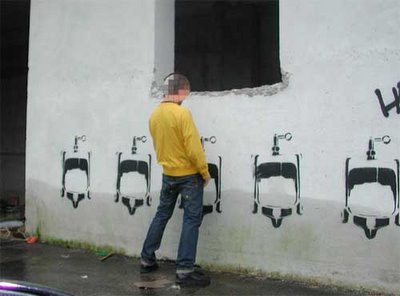 A nicely redesigned Wooster Collective posts a street-stencil that gives back-alley drunks something to aim at. A quick gag, it's similar to what artist Robin Rhode did—to more compelling effect—in South Africa:
A nicely redesigned Wooster Collective posts a street-stencil that gives back-alley drunks something to aim at. A quick gag, it's similar to what artist Robin Rhode did—to more compelling effect—in South Africa:In Leak, Rhode takes aim at the sanctity of the art museum. Riffing on Marcel Duchamp's Fountain, an upturned store-bought urinal signed with the alias R. Mutt, Rhode drew a urinal on a wall in the South African National Gallery and proceeded to "fill" it. In an apparent critique of whose art gets hung in the official halls of postcolonial South Africa, he signed the work R. Moet, the Afrikaans spelling of Duchamp's pseudonym. Taking a back-alley piss—the male act of marking territory—on the clean white walls of the museum sends a clear message to the art world: the museum, like the claimed turf of the graffiti writer, is ours.
Tom of Fitty
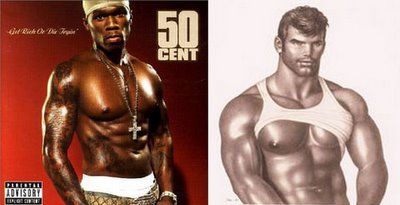 Cue your copy of the Queen-vs.-50 Cent mashup, cuz BlackBloggah is pondering the shared aesthetic of 50 Cent and gay-porn illustrator Tom of Finland—but he's got a very serious point:
Cue your copy of the Queen-vs.-50 Cent mashup, cuz BlackBloggah is pondering the shared aesthetic of 50 Cent and gay-porn illustrator Tom of Finland—but he's got a very serious point:AN OLD SHRINK OF MINE USED TO SAY, "The fear is the fascination" as a warning to me about how we are attracted to and unconsciously become what we fear, despise and hate. I experienced this principle growing up in Israel when I suffered racism from Jewish children whose parents railed against Nazism while unconsciously inculcating it in their own culture. And, I believe that this same principle is at work in the twin appearances of rampant homophobia and homo-hate in corporate hip hop, Jamaican culture and African culture throughout the Diaspora - and the fact that Black women in the U.S. suffer from the highest rates of new AIDS cases contracted by million of men living the "DL Lifestyle."
As a people, we have not come to terms with the facts of homosexuality, nor have we come to understand that the fight for GLBT civil rights is the logical and moral extension of the fight for our own rights. And as Black men, our failure to acknowledge, accept, welcome and celebrate all people regardless of sexual preference is directly related to the fact that we pass on AIDS faster than any other demographic in the U.S. We become what we fear and despise, period.
So, I submit this little trope and the above bits of visual culture to serve my argument that - hyper machismo equals homoerotic.
Philip Morris markets Maori smokes... to Israel
 New Zealand's Maori already have high rates of smoking (it's the number-one killer), so it's understandable that health advocates are incensed by a brand of cigarettes marketed with their name. Philip Morris has launched the brand Maori Mix in Israel; it bears a map of New Zealand and quasi-Maori designs. Shane Bradbrook of the Maori Smokefree Coalition (Te Reo Marama) makes a good point: "Would we have them here and call them Jewish Mix? It would be as offensive to the people in Israel as it is offensive for Maori."
New Zealand's Maori already have high rates of smoking (it's the number-one killer), so it's understandable that health advocates are incensed by a brand of cigarettes marketed with their name. Philip Morris has launched the brand Maori Mix in Israel; it bears a map of New Zealand and quasi-Maori designs. Shane Bradbrook of the Maori Smokefree Coalition (Te Reo Marama) makes a good point: "Would we have them here and call them Jewish Mix? It would be as offensive to the people in Israel as it is offensive for Maori." Aside from health issues, it appears to be a violation of the Maori "brand": the Maori have a trademark of sorts.

Called Toi Iho, it's a process for the development of products based on Maori imagry and culture. The mark (at right) has been created to "distinguish Maori arts and crafts from other arts and crafts; promote Maori art and artists nationally and internationally; assist Maori to retain ownership and control of their taonga – Maori knowledge, imagery and designs; [and] maintain the integrity of the Maori art culture."
Earlier: The Face of Maori Resistance.
Acquired Art Crusade
 An anonymous artist has put 450 hand-stamped bills into circulation in a project that's "about being lucky enough to come across art in an unusual way and aware enough of what your giving and receiving-- as not to miss it and accidently give it away. It takes the class system out of ownership." More images here.
An anonymous artist has put 450 hand-stamped bills into circulation in a project that's "about being lucky enough to come across art in an unusual way and aware enough of what your giving and receiving-- as not to miss it and accidently give it away. It takes the class system out of ownership." More images here.Earlier: "Lost dollar bill. If found, return to..."
12.14.2005
The Antarctic Snow Cruiser
 When today's snowstorm ends, Minnesotans will be buried under anywhere from five to 12 inches of snow. This would seem like the perfect vehicle for these conditions, the Antarctic Snow Cruiser. Well, sort of. When the cruiser was developed by Dr. Thomas C. Poulter for use in Antarctica in 1939, it didn't live up to expectations: the vehicle sank in the snow and it's wheels spun. To improve traction, they made a few modifications, including installing chains on the rear tires. Below, a scale model of one of the possible variations on the machine, which is also dubbed The Penguin.
When today's snowstorm ends, Minnesotans will be buried under anywhere from five to 12 inches of snow. This would seem like the perfect vehicle for these conditions, the Antarctic Snow Cruiser. Well, sort of. When the cruiser was developed by Dr. Thomas C. Poulter for use in Antarctica in 1939, it didn't live up to expectations: the vehicle sank in the snow and it's wheels spun. To improve traction, they made a few modifications, including installing chains on the rear tires. Below, a scale model of one of the possible variations on the machine, which is also dubbed The Penguin.  (Via W-M-M-N-A.)
(Via W-M-M-N-A.)
Gravestones for "invasive" trees
Jeremy Mora writes in with an interesting story. In LA (as here in Minneapolis), the condo boom continues unabated. Part of the condoization of the neighborhood involves fixing sidewalks that've heaved up from the expanding of roots by ancient trees. Apparently they're cutting down these "invasive trees" and marking the carnage like this:  Jeremy says ten trees were leveled and marked like this on Alameda in downtown Los Angeles.
Jeremy says ten trees were leveled and marked like this on Alameda in downtown Los Angeles.
Also: Jeremy points out a friend's blogworthy site, Treestories.
 Jeremy says ten trees were leveled and marked like this on Alameda in downtown Los Angeles.
Jeremy says ten trees were leveled and marked like this on Alameda in downtown Los Angeles. Also: Jeremy points out a friend's blogworthy site, Treestories.
Portable amplification
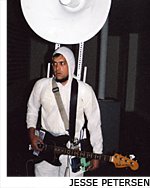 I'm on the board of a Minneapolis theater company, Flaneur Productions (one of 12 companies in the US dubbed "hot, hip, and on the verge" by American Theatre last December). Among our season of avant-garde performance, we host a festival of underground music called Heliotrope. Today's City Pages includes an anecdote from the 2005 edition in its Local Music Yearbook '05; White Map is made up of Low's Zak Sally and Scott Brown of Skin of Earth:
I'm on the board of a Minneapolis theater company, Flaneur Productions (one of 12 companies in the US dubbed "hot, hip, and on the verge" by American Theatre last December). Among our season of avant-garde performance, we host a festival of underground music called Heliotrope. Today's City Pages includes an anecdote from the 2005 edition in its Local Music Yearbook '05; White Map is made up of Low's Zak Sally and Scott Brown of Skin of Earth:Testing the concept of portable amplification during the second annual Heliotrope Festival, guitarist Scott Brown begins his set with White Map standing outside Franklin Art Works. He then walks into the show wearing his equipment—a backpack fitted with an amplifier (powered by a motorcycle battery), a belt with guitar effects, and a speaker cone that looks like a tuba above his head. Before joining drummer Zak Sally onstage, he's able to weave through the audience unhindered.As we launch a new season, we're beginning a fundraising effort. If you could pitch $5 our way, that'd be swell. It's tax-deductible.
12.13.2005
Thanks, Utne.
There's a mention of Eyeteeth in the current issue of Utne. My post on monkmobiles in Thailand, which was featured in their web watch in October, is blurbed in the November/December print issue. Thanks for the plug.
12.12.2005
Temporary park(ing)
 Almost three-quarters of San Francisco's downtown public space is set aside for private vehicles, far more than is allotted for parks. On November 16, the group Rebar set out to make a point about such lopsided priorities by creating a temporary park in a parking space—a spot with ideal sun between noon and 2 pm in a part of town without adequate green space—and inviting people to plug the meter to continue leasing the plot they'd covered with rolled-out sod, a park bench, and a shade tree. When time expired, they returned it to its cellulose-free concrete state when time was up. Beautiful!
Almost three-quarters of San Francisco's downtown public space is set aside for private vehicles, far more than is allotted for parks. On November 16, the group Rebar set out to make a point about such lopsided priorities by creating a temporary park in a parking space—a spot with ideal sun between noon and 2 pm in a part of town without adequate green space—and inviting people to plug the meter to continue leasing the plot they'd covered with rolled-out sod, a park bench, and a shade tree. When time expired, they returned it to its cellulose-free concrete state when time was up. Beautiful!(Via StayFree.)
12.10.2005
GOP diagnoses
Rumsfeld's senility: Yesterday, a willfully forgetful defense secretary said, "I don’t know anybody who had any reasonable expectations about the number or the length of the war or the cost of the war. I just don’t — no one I know went out and said these are how those three metrics ought to be considered. And you can take it to the bank." Here's what ThinkProgress is taking to the bank: Rummy is on record for predicting a war that would be short ("six months"), inexpensive ("50 billion to $60 billion"), and with low casualties ("we will be greeted as liberators").
Bush's cognitive degeneration: Comparing footage of Governor Bush to president Bush (video here), Information Clearinghouse talks of "a striking decline in his sentence-by-sentence speaking skills" and "pre-senile dementia."
Delay's heart attack: Writing that Tom Delay is a millstone around the GOP's neck, the New York Times diagnoses the former majority leader's tactics as "political hubris on a national scale, directed at the heart of democracy."
Bush's cognitive degeneration: Comparing footage of Governor Bush to president Bush (video here), Information Clearinghouse talks of "a striking decline in his sentence-by-sentence speaking skills" and "pre-senile dementia."
Delay's heart attack: Writing that Tom Delay is a millstone around the GOP's neck, the New York Times diagnoses the former majority leader's tactics as "political hubris on a national scale, directed at the heart of democracy."
Fabbing the future
 This week I read Bruce Sterling's new book Shaping Things for a possible writing gig. His ideas about a future in which space- and time-aware products ("spimes") can be manufactured (or "fabbed") right on our home desktops feels like science fiction. Yet as my recent post on 3D printers that can generate sheets of heart-muscle cells and "printable electronics" suggests, it's not so far off. Regine adds to that sense, writing on experiments by Royal College designers with rapid-prototyping equipment created by 3D Systems. "The brief was to create projects that are not prototypes but products that couldn't have been made with any other technique," she writes, and students delivered, creating a variety of products from a snap-off calendar to a functional gun.
This week I read Bruce Sterling's new book Shaping Things for a possible writing gig. His ideas about a future in which space- and time-aware products ("spimes") can be manufactured (or "fabbed") right on our home desktops feels like science fiction. Yet as my recent post on 3D printers that can generate sheets of heart-muscle cells and "printable electronics" suggests, it's not so far off. Regine adds to that sense, writing on experiments by Royal College designers with rapid-prototyping equipment created by 3D Systems. "The brief was to create projects that are not prototypes but products that couldn't have been made with any other technique," she writes, and students delivered, creating a variety of products from a snap-off calendar to a functional gun.
When Enlightenment hits like a ton of bricks
 "Two Buddhist monks pray in the Wat Tham Yod Thong temple, in the Ratchaburi province, Thailand. Their helmets protecting them in case of falling rocks."
"Two Buddhist monks pray in the Wat Tham Yod Thong temple, in the Ratchaburi province, Thailand. Their helmets protecting them in case of falling rocks."
12.09.2005
Yet another potato miracle.
 "This is NOT a Hoax! This is a true miracle!" While Karin Winkler has a point—the world should pursue peace—I'm not sure a wormy potato is sending exactly that message. Winkler, in true Christian style, is reportedly auctioning the cross-marked potato on eBay. She won't be alone: a potato chip with the "Holy Cross" on it has already racked up $5 in bids, and another, the "Christ Chip," allegedly (I can't see it) shows Jesus on the Cross. Current bid: $3.33, with $7 for shipping and handling.
"This is NOT a Hoax! This is a true miracle!" While Karin Winkler has a point—the world should pursue peace—I'm not sure a wormy potato is sending exactly that message. Winkler, in true Christian style, is reportedly auctioning the cross-marked potato on eBay. She won't be alone: a potato chip with the "Holy Cross" on it has already racked up $5 in bids, and another, the "Christ Chip," allegedly (I can't see it) shows Jesus on the Cross. Current bid: $3.33, with $7 for shipping and handling.Non-starch-based miracles: Jesus on a wampum shell, Jesus on a shark's tooth, Jesus in a catfish bone, the Navity scene in an agate, and, from a few days ago, F-150 Jesus.
Simon Starling's cryptic critiques
 Amid the protests of some, artist Simon Starling won the prestigious Turner Prize this week for his project Shedboatshed, in which he dismantled a wooden shed he found along the Rhine, tranformed it into a boat which he then navigated downstream to Basel where he reconstructed it once again as a shed. His work is compelling to me because it often frames the political in less obvious, often unexpected, and sometimes confounding ways. Take his project planned for next fall, which involves chucking a sculpture from the Art Gallery of Ontario's collection into Lake Ontario: "There is a big problem with zebra mussels in the lake which have invaded and taken over, and there is a Henry Moore in Toronto called Warrior with Shield. I thought it would be nice to grow some mussels on the Henry Moore for six months, then take it out and exhibit it in a museum." Or his Tabernas Desert Run, a hydrogen-fuelled bicycle on which he crossed the Spanish desert. While his work can be puzzling, it often seems socially engaged without being so overt and angry as to guarantee its eventual irrelevance: while some art that addresses current issues can (and must, at times) be direct in protesting or informing, which means it's visceral power is tied to one time and place, Starling's art remains cryptic enough to contain new meanings for different times.
Amid the protests of some, artist Simon Starling won the prestigious Turner Prize this week for his project Shedboatshed, in which he dismantled a wooden shed he found along the Rhine, tranformed it into a boat which he then navigated downstream to Basel where he reconstructed it once again as a shed. His work is compelling to me because it often frames the political in less obvious, often unexpected, and sometimes confounding ways. Take his project planned for next fall, which involves chucking a sculpture from the Art Gallery of Ontario's collection into Lake Ontario: "There is a big problem with zebra mussels in the lake which have invaded and taken over, and there is a Henry Moore in Toronto called Warrior with Shield. I thought it would be nice to grow some mussels on the Henry Moore for six months, then take it out and exhibit it in a museum." Or his Tabernas Desert Run, a hydrogen-fuelled bicycle on which he crossed the Spanish desert. While his work can be puzzling, it often seems socially engaged without being so overt and angry as to guarantee its eventual irrelevance: while some art that addresses current issues can (and must, at times) be direct in protesting or informing, which means it's visceral power is tied to one time and place, Starling's art remains cryptic enough to contain new meanings for different times. More on Starling, including audio interviews, here. Via Treehugger.
Earlier: "A Shaman's Call: Joseph Beuys and America."
War bad for recruiting
 The fact that soldiers are dying in Iraq—2,135 so far—isn't a good marketing point for Army recruiters. Which is why recruiters in Duluth aren't fond of the sign in a storefront window next door that reads "Iraq. Remember the Fallen Heroes," featuring a changing count of the dead. The sign was put up by a veterans-rights activist, Scott Cameron, who was shot in the back in the Vietnam war. Cameron volunteers for gubernatorial candidate Steve Kelley, whose campaign office is next to the recruiter's office. Army Staff Sgt. Gary Capan says his employees, including a just-returned Iraq vet, Army Staff Sgt. Gary Capan, dislike the sign, which will stay up: "It kind of disturbed her and it is a little unsettling, especially for people wanting to join the military. It makes it so the troops are just a number."
The fact that soldiers are dying in Iraq—2,135 so far—isn't a good marketing point for Army recruiters. Which is why recruiters in Duluth aren't fond of the sign in a storefront window next door that reads "Iraq. Remember the Fallen Heroes," featuring a changing count of the dead. The sign was put up by a veterans-rights activist, Scott Cameron, who was shot in the back in the Vietnam war. Cameron volunteers for gubernatorial candidate Steve Kelley, whose campaign office is next to the recruiter's office. Army Staff Sgt. Gary Capan says his employees, including a just-returned Iraq vet, Army Staff Sgt. Gary Capan, dislike the sign, which will stay up: "It kind of disturbed her and it is a little unsettling, especially for people wanting to join the military. It makes it so the troops are just a number."
12.08.2005
Go, Bernie!
 Congressman Bernie Sanders (D-VT) blasts Bush—and then goes beyond it:
Congressman Bernie Sanders (D-VT) blasts Bush—and then goes beyond it:Question: What does Hurricane Katrina tell us?Go, Mike! Wallace, that is: "What in the world prepared you to be the commander in chief of the largest superpower in the world? In your background, Mr. President, you apparently were incurious. You didn't want to travel. You knew very little about the military. . . . Do you think that has anything to do with the fact that the country is so [expletive] up?"
Bernie Sanders: I think Katrina is one more indication of how inefficient and corrupt this Administration is, and indicates the absolute lack of seriousness that Bush has in making the government respond to the needs of the people. He is there primarily to give tax breaks to billionaires, to do the service of large corporations. This is just one more powerful, dramatic, painful example of the incompetence and lack of concern of this Administration. They are so separated from the lives of normal, low-income people that it never occurred to them that if you’re poor and have no money, no car, that you can’t leave. You don’t just get in your SUV and go to a nice hotel a few miles away...
Q: So what’s your message to progressives?
Sanders: We have got to change the political culture in America. We need a political revolution. That means we are working on politics not just three weeks before an election but 365 days a year. We have to develop a strong economic message which says every American is entitled to health care through a national health care program. And we’re not going to allow these large corporations to push through trade agreements which allow them to throw Americans out on the street and run to China. We’re not going to give tax breaks to billionaires and then cut back on the needs of our elderly or poor or kids or education. We’re not going to privatize Social Security—in fact, we’re going to strengthen it. We’re going to provide quality education for every kid in America, from preschool through college. We have to take on these corporate leaders who are selling out the American people, whose allegiance is now much more to China than it is to the United States. If we have the courage to take these people on, I think we can overwhelm Bush and his friends.
Senatorial Wiki
12.07.2005
Smile, you're in hell.
 Giselle just dropped off this ad for Tourismo Madrid, torn from a travel magazine. The headline seems to suggest viewing Picasso's Guernica, a visceral depiction of Franco's 1937 massacre of 1600 civilians in the Basque city of the same name, is something to grin about.
Giselle just dropped off this ad for Tourismo Madrid, torn from a travel magazine. The headline seems to suggest viewing Picasso's Guernica, a visceral depiction of Franco's 1937 massacre of 1600 civilians in the Basque city of the same name, is something to grin about. [Image via Gawker.]
Graffiti hackers
 Wired runs down a list of high-tech graffiti tools, some, like the Troika SMS projector and a suction-cup subway projector, that have been featured here. Here's "a paintball rifle modded into a point-and-shoot brush":
Wired runs down a list of high-tech graffiti tools, some, like the Troika SMS projector and a suction-cup subway projector, that have been featured here. Here's "a paintball rifle modded into a point-and-shoot brush":The gun is mounted on a pan-and-tilt unit that's controlled remotely by a laptop. Software analyzes a digital image and creates a set of coordinates that the device uses to aim and fire ink bullets at three shots per second, essentially turning the paintball gun into a large-scale inkjet printer. De Ponk named the machine PrintBall. Its designs - words, smiley faces, shapes - are primitive. But the co-op hopes to try four-color printing using cyan, yellow, magenta, and black pellets, and eventually wants to take its graffiti bot to the streets.Earlier: Hi-tech protest tools used at the Republican National Convention.
Word: "Paintball guns are used to simulate war, so we wanted to convert one into a communication weapon," explains a group member who calls himself bnjmn Gaulon.
Homeland Security Holiday
 If the Playmobil Security Checkpoint isn't quite right for your post-9/11 holiday gift-giving, try this, the Terror Alert Xylophone from BabyBush toys.
If the Playmobil Security Checkpoint isn't quite right for your post-9/11 holiday gift-giving, try this, the Terror Alert Xylophone from BabyBush toys.
I'll be closed for Christmas.
Some of the country's biggest megachurches will be closed on Christmas, a Sunday, because of anticipated low attendance. "This is a consumer mentality at work: 'Let's not impose the church on people. Let's not make church in any way inconvenient,' " said David Wells, professor of history and systematic theology at the evangelical Gordon-Conwell Theological Seminary. "I think what this does is feed into the individualism that is found throughout American culture, where everyone does their own thing." As an apt MetaFilter headline puts it, "Christ died for your convenience."
Breaking...
The voice of God George Bush claims to have been hearing has been revealed to be Dick Cheney speaking on the White House intercom.
Panoramic photography of the head.
 Game developers are working on applications to plot a panoramic photo of a man's head. While the technology's new, the basic idea isn't. Here's Kiki Smith's self-portrait, a photogravure created in 1995. (It's on view now at SFMOMA and at the Walker starting in February.)
Game developers are working on applications to plot a panoramic photo of a man's head. While the technology's new, the basic idea isn't. Here's Kiki Smith's self-portrait, a photogravure created in 1995. (It's on view now at SFMOMA and at the Walker starting in February.)
12.06.2005
The 100-Mile Diet
 On the first day of Spring 2005, writers James MacKinnon and Alisa Smith took a vow—"to live with the rhythms of the land as our ancestors did. For one year we would only buy food and drink for home consumption that was produced within 100 miles of our home" in British Columbia. The set simple rules: aside from dinners at restaurants or friends' homes, every ingredient must be locally produced.
On the first day of Spring 2005, writers James MacKinnon and Alisa Smith took a vow—"to live with the rhythms of the land as our ancestors did. For one year we would only buy food and drink for home consumption that was produced within 100 miles of our home" in British Columbia. The set simple rules: aside from dinners at restaurants or friends' homes, every ingredient must be locally produced. Their adventure, chronicled in an online journal at Tyee.ca, has posed challenges those of us on a 2,500-mile diet might not even fathom: if you're buying locally, you've only got seasonal and regional food options. They tell of canning strawberries (where do you get sugar for canning within 100 miles of Vancouver?), baking bread (grain, including the barley used to make—gasp—beer is surprisingly hard to come by in BC), and pondering the food politics of local meats (pink salmon, organic chickens)—not to mention the challenge of affording all this pure, pesticide-free food.
As they admit, "This may sound like a lunatic Luddite scheme," but their reasons are compelling:
The short form would be: fossil fuels bad. For the average American meal (and we assume the average Canadian meal is similar), World Watch reports that the ingredients typically travel between 2,500 and 4,000 kilometres, a 25 percent increase from 1980 alone. This average meal uses up to 17 times more petroleum products, and increases carbon dioxide emissions by the same amount, compared to an entirely local meal.But, really, they say, it's about the enjoyment of food. Recently, spending a weekend at my parents' 80-acre plot in Central Wisconsin, I enjoyed the closest thing I've ever had to such a meal: turkey and venison killed in my parents' woods by the family hunters, corn purchased from a neighbor down the road, salad and veggies grown organically in the garden, and grocery store milk that undoubtedly came from a local (although probably not organic or BGH-free) dairy. It was delicious—and, honestly, a little weird knowing that just about everything I'd eaten once lived, and was killed, on the very land where I ate. But shouldn't the weirdness be the other way around, that it's strange to nourish one's body with trucked-in food that was grown, killed, or slaughtered far away by someone you'll never meet?
(Thanks, Leif.)
Printing out kidneys and tennis shoes
 Two dimensions just aren't enough for developers of printers: soon, human organs or fabricated products might come out of your desktop printer. OK, maybe that's a stretch—at least, right now—but scientists are developing printers that can use bio-ink and bio-paper to print out three-dimensional biological materials. So far, researchers at three American universities have collaborated to create technology that can print tubes akin to blood vessels and sheets of heart muscle cells. Glenn Prestwich of the University of Utah's team says that he thinks they'll be able to print kidneys and livers eventually.
Two dimensions just aren't enough for developers of printers: soon, human organs or fabricated products might come out of your desktop printer. OK, maybe that's a stretch—at least, right now—but scientists are developing printers that can use bio-ink and bio-paper to print out three-dimensional biological materials. So far, researchers at three American universities have collaborated to create technology that can print tubes akin to blood vessels and sheets of heart muscle cells. Glenn Prestwich of the University of Utah's team says that he thinks they'll be able to print kidneys and livers eventually. In the product realm, Future Feeder links to a Salon article by Boingboing's David Pescowitz, on "desktop manufacturing." He writes that designers have used 3D printing for a decade to create prototypes of products, but new technology is being developed to make such devices functional:
Researchers at many corporate and university laboratories are brewing inks of semiconducting nanocrystals and using cannibalized inkjet printers to pattern the nanomaterials into circuits on plastic, paper and even cloth. Printable electronics is likely to hit the mainstream first in flexible displays that can be cranked out in rolls and then as UPC bar-code-killing RFID (radio frequency identification) tags stamped right on a product package.--snip--
The next step is to print mechanical structures -- motors and actuators, devices for controlling or moving something. At MIT, Joseph Jacobson and his students have printed microscopic linear drive motors, similar to pistons, and thermal actuators that are triggered by heat. These kinds of pinhead-size devices, called MEMS (micro-electromechanical systems), are found in everything from automobile air bags to dishwashers. To make larger mechanisms, such as the components that cause a blender's blades to spin when it's switched on, Canny and his Berkeley colleagues propose filling inkjet cartridges with electroactive polymers, essentially plastic that contracts when zapped with electricity. The same material generates a voltage when flexed, making it an ideal choice for buttons or switches in a printed object.
Gameboy for diabetics
 A glucose meter that can be inserted into a Nintendo Gameboy, Glucoboy "operates independent of the video game system but downloads video game programs that are contained within its circuitry into the GAMEBOY as a reward for maintaining good blood sugar control."
A glucose meter that can be inserted into a Nintendo Gameboy, Glucoboy "operates independent of the video game system but downloads video game programs that are contained within its circuitry into the GAMEBOY as a reward for maintaining good blood sugar control."
12.05.2005
A divinely inspired art proposal
 This likeness of Christ, "miraculously" appearing on the tailgate of a North Carolina pickup truck, looks suspiciously like a stencil. So why not make it legit? Street artists oughta create their own "miracles" and make the face of Jesus, the Virgin Mary, Gandhi, MLK, whomever, mysteriously appear in cities across America. God knows we could use a little inspiration to actually act like these people. (Send me your pix if you do.)
This likeness of Christ, "miraculously" appearing on the tailgate of a North Carolina pickup truck, looks suspiciously like a stencil. So why not make it legit? Street artists oughta create their own "miracles" and make the face of Jesus, the Virgin Mary, Gandhi, MLK, whomever, mysteriously appear in cities across America. God knows we could use a little inspiration to actually act like these people. (Send me your pix if you do.)
Gift for the geek in your life.
 I guess I'm outing myself as a fella of a certain age with a certain sense of humor, but... buy this for me: a seven-inch tall plush version of the Black Knight from Monty Python and the Holy Grail. He's got velcro arms and legs for repeated limb-severing.
I guess I'm outing myself as a fella of a certain age with a certain sense of humor, but... buy this for me: a seven-inch tall plush version of the Black Knight from Monty Python and the Holy Grail. He's got velcro arms and legs for repeated limb-severing.
Quiklinks
OK to be gay in the UK: Britain has legalized same-sex marriage.
Accomplices to the north? Is the CIA running torture flights through Canada?
Help Wanted: Looking for a "Clandestine Service Career"? The CIA is hiring.
Vote, maybe. Even though I'm not on there, vote for The Weblog Awards anyway. If you want.
Chucklehound: Researchers say a dog's long, loud panting is actually doggy laughter.
More to come...
Accomplices to the north? Is the CIA running torture flights through Canada?
Help Wanted: Looking for a "Clandestine Service Career"? The CIA is hiring.
Vote, maybe. Even though I'm not on there, vote for The Weblog Awards anyway. If you want.
Chucklehound: Researchers say a dog's long, loud panting is actually doggy laughter.
More to come...
A bicycle built for Rube
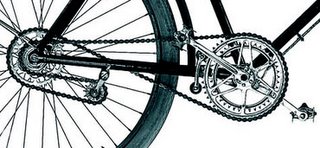
Rube Goldberg's bike might've been the Hirondelle Rétro-Directe with its convoluted chain and two hubs. Featured in the book The Golden Age of Handbuilt Bicycles, the bike was built before rear derailleurs were commercially available, writes Fat Cyclist (although it includes the first commercial front derailleur). Here's the hitch:
But people still wanted to go up hills. The Hirondelle's solution was to give you two gears in the back. Simply pedal normally for the higher gear.(Via The Daily Irrelevant.)
And what do you do when it's time to climb? Pedal backwards.
12.04.2005
Alternative X-mas
 Time for my annual link to Buy Nothing Christmas, the alternative holiday site run by an old Adbusters colleague, Aiden Enns. It's filled with resources for a nonconsumer Christmas, including printable pdfs for coupons you can give as gifts (for childcare or back massages, for instance), to study guides on the Christian roots of Christmas, ideas from Bill McKibben's book Hundred-Dollar Holiday, and more.
Time for my annual link to Buy Nothing Christmas, the alternative holiday site run by an old Adbusters colleague, Aiden Enns. It's filled with resources for a nonconsumer Christmas, including printable pdfs for coupons you can give as gifts (for childcare or back massages, for instance), to study guides on the Christian roots of Christmas, ideas from Bill McKibben's book Hundred-Dollar Holiday, and more.
The Snow Show
 The art in The Snow Show uses various forms of water--from packed snow to cast ice--to realize architectural/sculptural works by international artists from Carsten Holler to Kiki Smith to Rachel Whiteread. The 2006 edition will be held in Sestriere in the Italian Alps to coincide with the Winter Olympics. View previous years' works here.
The art in The Snow Show uses various forms of water--from packed snow to cast ice--to realize architectural/sculptural works by international artists from Carsten Holler to Kiki Smith to Rachel Whiteread. The 2006 edition will be held in Sestriere in the Italian Alps to coincide with the Winter Olympics. View previous years' works here. Left: Robert Barry & Hollmen, Reuter, Sandman's Lanterns of Ursa Minor, 2004
Below: Osmo Rauhala & ASYMPTOTE's Absolute Zero: A Lighthouse of Temporality, 2003
 And: Returning to a frozen lake in Minnesota for the second year, the Soap Factory's Art Shanty Projects, artist-designed icefishing shacks. See last year's entries at mnartists.org.
And: Returning to a frozen lake in Minnesota for the second year, the Soap Factory's Art Shanty Projects, artist-designed icefishing shacks. See last year's entries at mnartists.org.
Subscribe to:
Posts (Atom)








